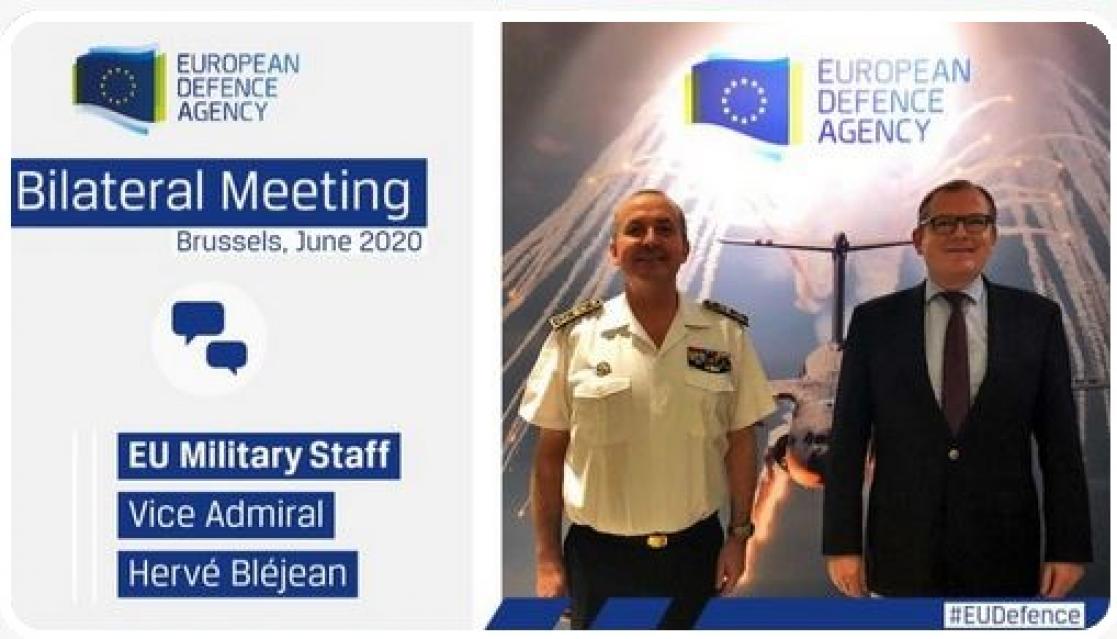EDA and EUMS: Distinct Partners, Common Goals

Introduction
EDA and EUMS are both indispensable in the European Union’s institutional defence architecture. While EDA offers the platform and expert hub for collaborative defence

research and capability development in Europe, the EUMS - under the direction of the EU High Representative/Vice President of the Commission, as well as the EU Military Committee (EUMC) - supports the European External Action Service (EEAS) and has thus the crucial role of coordinating the military instrument, with a particular focus on EU CSDP missions and operations, both military and civilian requiring military support. This division of labour has proven itself: here, the EUMS dealing with the operational, military aspects of CSDP missions and operations as well as the identification of CSDP related military requirements and related capability shortfalls through the Headline Goal Process; there, EDA with a broad mandate to look at the entire European defence capability landscape, facilitating and managing collaborative defence capability development and research to support Member States in their related efforts. Two sets of roles and tasks that are unique and therefore complementary. Both must be used hand-in-hand to support a strong European defence landscape from which the forces and capabilities are drawn to conduct military operations effectively.
Hence the need for close cooperation and complementarity between the EUMS and EDA; something our two institutions have cultivated and practised throughout the years.
Capability Development Plan (CDP)

A prime example of our good cooperation is the revision of the agreed EU Capability Development Priorities derived from the Capability Development Plan (CDP). Since 2008, the EDA has been producing the CDP to address short- to mid- and long-term security and defence challenges, which also benefits from key contributions provided by Member States, as well as the EUMC and the EUMS. The CDP includes the results of the military Headline Goal Process which sets the requirements for military CSDP, but also long-term trends and Member States’ national plans and programmes, including the R&T and industrial dimension, which contributes to coherent long-term capability development amongst Member States. The CDP is created to guide decision-making at EU and national levels regarding defence capability development and to provide a set of the agreed EU Capability Development Priorities, as a common reference for CARD, PESCO and the EDF. The overall objective is to increase coherence between Member States’ defence planning and to encourage European cooperation by looking together at future operational needs.
The CDP revision benefits from several inputs such as the Headline Goal Process, studies on long-term trends, lessons learned from missions and operations and information on current plans and programmes. The resulting EU Capability Development Priorities are the outcome of an in-depth assessment conducted on the basis of contributions provided by Member States, EUMC and EUMS on short-term, mid-term and long-term capability trends: capability shortfalls analyses and lessons learned from recent CSDP operations provided by the EUMC, defence plans and their potential for future European cooperation in each of the capability domains, and long-term capability trends and evolution of related military needs based on technological perspective (2035 and beyond), benefiting from EDA expertise in defence R&T domain.
CARD

EDA and the EUMS also have shared responsibilities (together with the EEAS) in the secretariat of the EU’s Coordinated Annual Review on Defence (CARD). The CARD is a key tool in support of the overall coherence of defence capability development in the EU. It has the function to provide a comprehensive overview of the European defence landscape over time and also serves as a pathfinder for collaborative opportunities. The first full CARD cycle was completed last November when EDA delivered to Ministers of Defence the 2020 CARD Report with a comprehensive set of findings on the current defence landscape and actionable recommendations on how to reduce the fragmentation of European defence landscape and boost joint planning, defence research and collaborative capability development in the future. Together with the EEAS, the EUMS was fully engaged in all four phases of the CARD exercise - preparation of the CARD initial information, bilateral dialogues with Member States, CARD analysis, drafting of the final CARD Report. In particular, the EEAS/EUMS contributed with an analysis of the implementation of the High Impact Capability Goals (HICGs), an analysis of participating Member States’ operational activities and resulting collaborative opportunities in support of CSDP operations and missions.
Here again, without such close cooperation, the final CARD assessment, findings and recommendations would not have been as informative and operational for the future as they proved to be. We should pursue on this cooperative path for the next CARD cycles.
PESCO
EDA and the EEAS/EUMS also work together very fruitfully in the PESCO secretariat which serves as a platform where the Member States participating in the Permanent Structured Cooperation can identify, assess and consolidate possible projects to make sure they respond to capability gaps and priorities previously identified in the CDP. While we work hand-in-hand in the PESCO secretariat, each of us has its specific role to play. The EUMS and EEAS notably contribute to the High Representative’s (HR) annual assessment of PESCO Member States’ contributions with regard to operational aspects and the contribution of proposed PESCO projects to operational needs. EDA complements the HR’s assessment of Member States’ contributions with regard to capabilities. In addition, EDA facilitates collaborative capability development projects, including by ensuring that there is no unnecessary duplication with existing initiatives also in other institutional contexts.
As already said before: a division of labour that has proved its merits and, therefore, should be continued in the future.
Support to missions & operations
Another important - and growing - dimension of the EDA-EUMS cooperation is the support the Agency provides to CSDP missions and operations by offering different tools and instruments to mission commanders. Today, these services range from commercially procured Satcom solutions (EU Satcom Market project) and the pooling & sharing of governmental satellite communications (GOVSATCOM Demo project) to maritime surveillance support (MARSUR project), the provision of commonly procured air medical evacuation (AIRMEDEVAC project), geospatial information support (GISMO project), common diplomatic clearances for the crossing of airspaces/land and the organisation of cyber awareness seminars for mission headquarters, to name only them. By putting all those existing (and potential future) services at the disposal of Member States and the various CSDP missions and operations, EDA helps the EUMS and EUMC to create the right circumstances in which the military can conduct their operations and missions in the field, together with their civilian partners. EDA is proud to be part of that endeavour and will further enhance its efforts in that domain in the future.

EDA-EUMS cooperation is indispensable and will remain in the future. The various EU defence actors should indeed work together, as each of them plays its specific role and brings to the table its own expertise while working for the same common objective: to make European defence stronger, together.
Happy Birthday, EUMS!





